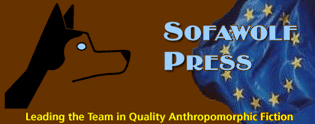



|
 |

|
|
|
For those of you who have been here before, welcome to our new web site design. We hope it will be easier for you to find the information you need, and friendlier to a wider range of web client software. Be sure to try out our new online ordering system in the products section, and enjoy the new sofawolf.com experience. Some sections are still under development though, so bear with us while we retool for the future. If this is your first time visiting us, then our warmest greetings to you. If you've come here seeking the best collections of anthropomorphic fiction, then we think you've found them. If you've come here looking for one of the only semi-pro literature markets specializing in the anthropomorphic meta-genre, then we think you've found it too. If you have no idea what anthropomorphic even means in this context, then we hope to enlighten and intrigue you enough that you become one of the prior two visitors. What is 'anthropomorphic' anyway? An·thro·po·mor·phic \"an(t)-thr&-p&-'mor-fik\ adj [Late Latin anthropomorphus of human form, from Greek anthrOpomorphos, from anthrOp- + -morphos -morphous] (1827) 1 : described or thought of as having a human form or human attributes < ~ deities> 2 : ascribing human characteristics to nonhuman things < ~ supernaturalism>. (Webster's Ninth New Collegiate Dictionary [Springfield: Merriam-Webster Inc, 1988] 90.) So, we publish stories about talking toasters and dust mites, right? Well, not toasters, but we'd happily consider any talking dust mite stories sent our way. Our use of the term anthropomorphic is specific to talking animals. (For those fellow biologists out there, specifically the kingdom Metazoa in the grouping of Eukaryotic organisms.) This includes a diverse assortment of critters, but are most often represented in fiction by insects, reptiles, avians, and the ever-popular mammals. (Also mythological things like werewolves, dragons, griffons, and such...) While the first thing to spring to mind is probably children's literature, which is loaded with anthropomorphic stories and illustration, there are plentiful examples of the same devices at use in adult fiction. The most recognizable examples include: Watership Down by Richard Adams, and Animal Farm by George Orwell. Many SF&F genre writers often employ anthropomorphic characters in their novels for purposes ranging from serious human allegory to the simple addition of color and texture into the character base. Anthropomorphic characters can be goofy and farcical, violent and primal, noble and loyal, or petty and self-serving. They express the range of human emotion (often magnified or twisted by their animal natures) and can be either the focus of the story, a supporting character in the story's development, an obstacle to the hero's journey, or a traveling companion and source of wisdom. In recent years, anthropomorphic comics (which, with the addition of comic strips, account for a large percentage of the total material in active publication) such as Albedo and Xanadu have gained a strong and creative following of fans who not only follow the stories but contribute works of their own. The support for anthropomorphics in general has been steadily growing over the last fifteen years and now supports not only many thriving amateur publications, but also a dozen conventions a year worldwide. We invite you to browse our offerings in the product catalog, visit other anthropomorphic themed sites referenced in our links section, and explore the topics in our online features area. We hope you find much to captivate and educate you.
|
||||||||||||||||||||||||||||||||||||||